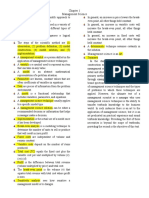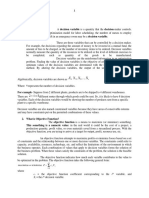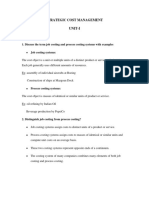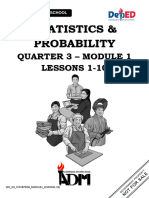Module 1
Uploaded by
nathaliefayeb.tajaModule 1
Uploaded by
nathaliefayeb.tajaModule 1: Management Science
What is Management Science
is a scientific approach to solving management problems.
can be used in a variety of organizations to solve many different types of problems
encompasses a logical approach to problem solving
The management science process
Observation
The system must be continuously and closely observed so that problems can be identified as soon as they
occur or are anticipated.
The person who normally identifies a problem is the manager because managers work in places where
problems might occur.
management scientist, a person skilled in the techniques of management science and trained to identify
problems, who has been hired specifically to solve problems using management science techniques.
Definition of the Problem
Once it has been determined that a problem exists, the problem must be clearly and concisely defined.
the existence of a problem im- plies that the objectives of the firm are not being met in some way, the
goals (or objectives) of the organization must also be clearly defined.
Model Construction
A management science model is an abstract representation of an existing problem situation.
It can be in the form of a graph or chart, but most frequently a management science model consists of a
set of mathematical relationships.
A variable is a symbol used to represent an item that can take on any value.
Parameters are known, constant values that are often coefficients of variables in equations.
Data are pieces of information from the problem environment.
A model is a functional relationship that includes variables, parameters, and equations.
The equation as a whole is known as a functional relationship (also called function and relationship).
The term is derived from the fact that profit, Z, is a function of the number of units sold, x, and the
equation relates profit to units sold.
Model Solution
A management science solution technique usually applies to a specific type of model. Thus, the model
type and solution method are both part of the management science technique. We are able to say that a
model is solved because the model represents a problem. When we refer to model solution, we also
mean problem solution.
Implementation
Implementation is the actual use of the model once it has been developed or the solution to the problem
the model was developed to solve.
Model Building: Break-Even Analysis
Break-even analysis is a modeling technique to determine the number of units to sell or produce that will
result in zero profit. also called profit analysis.
The point where total revenue equals total cost is called the break-even point, and at this point profit is
zero. The break-even point gives a manager a point of reference in determining how many units will be
needed to ensure a profit.
Components of Break-Even Analysis
The three components of break-even analysis are volume, cost, and profit.
Volume is the level of sales or production by a company. It can be expressed as the number of units (i.e.,
quantity) produced and sold.
2 types of cost:
Fixed costs are generally independent of the volume of units produced and sold.
Variable costs are determined on a per-unit basis. Thus, total variable costs depend on the number of
units produced.
Total variable costs are a function of the volume and the variable cost per unit. This relationship can be
expressed mathematically as:
total variable cost = vcv
The total cost of an operation is computed by summing total fixed cost and total variable cost, as follows:
total cost = total fixed cost + total variable cost or TC = cf + vcv
The third component in our break-even model is profit. Profit is the difference between total revenue and
total cost. Total revenue is the volume multiplied by the price per unit,
total revenue = vp
Computing the Break-Even Analysis
total profit = total revenue - total cost
We can verify this result by using our total profit formula,
Z = vp - cf – vcvn
At the break-even point, where total revenue equals total cost, the profit, Z, equals zero. Thus, if we
let profit, Z, equal zero in our total profit equation and solve for v, we can determine the break-even
volume:
Z = vp - cf – vcv
Graphical Solution
It is possible to represent many of the management science models in this text graphically and use these
graphical models to solve problems. Graphical models also have the advantage of providing a “picture” of
the model that can sometimes help us understand the modeling process better than mathematics alone can.
Sensitivity Analysis
The study of changes on a management science model is called sensitivity analysis—that is, seeing how
sensitive the model is to changes.
You might also like
- Introduction To Management Science - 473279351No ratings yetIntroduction To Management Science - 47327935112 pages
- Chapter One (Quantitative Mangement Approach)No ratings yetChapter One (Quantitative Mangement Approach)33 pages
- Continuation Lesson 1 Introduction To MGT Science With AssessmentsNo ratings yetContinuation Lesson 1 Introduction To MGT Science With Assessments8 pages
- CH 1-Ch 3 (Quantitative Mangement Approach)No ratings yetCH 1-Ch 3 (Quantitative Mangement Approach)114 pages
- Lesson 5 - The Management Science Approach to Problem Solving 2022 (Handout)No ratings yetLesson 5 - The Management Science Approach to Problem Solving 2022 (Handout)5 pages
- The Management Science Approach To Problem SolvingNo ratings yetThe Management Science Approach To Problem Solving6 pages
- Lesson 1 Prepared By: Asst. Prof. Sherylyn T. Trinidad: The Management ScienceNo ratings yetLesson 1 Prepared By: Asst. Prof. Sherylyn T. Trinidad: The Management Science17 pages
- Cost-Volume-Profit Analysis A Managerial Planning ToolNo ratings yetCost-Volume-Profit Analysis A Managerial Planning Tool3 pages
- Cost-Volume-Profit Analysis: A Managerial Planning Tool Break-Even Point in UnitsNo ratings yetCost-Volume-Profit Analysis: A Managerial Planning Tool Break-Even Point in Units3 pages
- Chapter_1-1.1_Review_of_Linear_Equations_and_Linear_Inequalities_-_Copy (2)No ratings yetChapter_1-1.1_Review_of_Linear_Equations_and_Linear_Inequalities_-_Copy (2)29 pages
- Cost of Concepts For Decision Making Ch. 3No ratings yetCost of Concepts For Decision Making Ch. 314 pages
- PUTRI ROUDINA MAS'UD - 041411331084 Accounting English ClassNo ratings yetPUTRI ROUDINA MAS'UD - 041411331084 Accounting English Class8 pages
- New Global Vision College: Quantitative Analysis For Business DecisionNo ratings yetNew Global Vision College: Quantitative Analysis For Business Decision31 pages
- Chapter 1 - Quantitative Mangement ApproachNo ratings yetChapter 1 - Quantitative Mangement Approach19 pages
- BANA 7012 Lecture 2.1 Models in AnalyticsNo ratings yetBANA 7012 Lecture 2.1 Models in Analytics21 pages
- Cost-Volume-Profit Analysis: Fixed CostsNo ratings yetCost-Volume-Profit Analysis: Fixed Costs9 pages
- Business Math F502 34036 Mohammad Faisal KarimNo ratings yetBusiness Math F502 34036 Mohammad Faisal Karim9 pages
- A Guide To Simulation With EViews by Afees Salisu PDFNo ratings yetA Guide To Simulation With EViews by Afees Salisu PDF31 pages
- Introduction To Managerial Decision ModelingNo ratings yetIntroduction To Managerial Decision Modeling59 pages
- Survey of Calculus and Its Applications IINo ratings yetSurvey of Calculus and Its Applications II3 pages
- SAT Suite Question Bank - Advanced MathNo ratings yetSAT Suite Question Bank - Advanced Math397 pages
- Soal Ujian Akhir Semester Statistika Bisnis Semester Genap T.A. 2018/2019 Jurusan Agribisnis Fakultas Pertanian UhoNo ratings yetSoal Ujian Akhir Semester Statistika Bisnis Semester Genap T.A. 2018/2019 Jurusan Agribisnis Fakultas Pertanian Uho6 pages
- Cost Concepts and Design Economics: Dr. Mohammad Abuhaiba, PE 1No ratings yetCost Concepts and Design Economics: Dr. Mohammad Abuhaiba, PE 137 pages
- VariantConfiguration DependencyDefinitionsNo ratings yetVariantConfiguration DependencyDefinitions24 pages
- CCGPS Math 6 Grade Unit 4 Study Guide: Name: Period: DateNo ratings yetCCGPS Math 6 Grade Unit 4 Study Guide: Name: Period: Date5 pages
- General Mathematics: Quarter 2 - Module 3: Solving Problems Involving Simple and Compound InterestNo ratings yetGeneral Mathematics: Quarter 2 - Module 3: Solving Problems Involving Simple and Compound Interest35 pages































































































